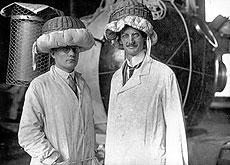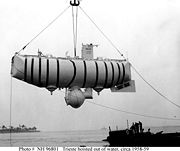Auguste Piccard
| Auguste Piccard | |
Auguste Piccard in 1927
|
|
| Born | January 28, 1884 Basel, Switzerland |
|---|---|
| Died | March 24, 1962 (aged 78) Lausanne, Switzerland |
| Nationality | Swiss |
| Fields | physics, inventor, explorer |
| Institutions | Free University of Brussels (now Université Libre de Bruxelles and Vrije Universiteit Brussel) |
| Alma mater | Swiss Federal Institute of Technology |
Auguste Antoine Piccard (January 28, 1884 – March 24, 1962) was a Swiss physicist, inventor and explorer. Piccard and his twin brother Jean Felix were born in Basel, Switzerland. Showing an intense interest in science as a child, he attended the Swiss Federal Institute of Technology in Zurich, and became a professor of physics in Brussels at the Free University of Brussels (now split into the Université Libre de Bruxelles and the Vrije Universiteit Brussel) in 1922, the same year his son Jacques Piccard was born. He was a member of the Solvay Congress of 1927.
Contents |
Career
In 1930, an interest in ballooning, and a curiosity about the upper atmosphere led him to design a spherical, pressurized aluminum gondola that would allow ascent to great altitude without requiring a pressure suit. Supported by the Belgian Fonds National de la Recherche Scientifique (FNRS) Piccard constructed his gondola.

Image courtesy of: Collection Musée du Léman, Nyon - Suisse
On May 27, 1931, Auguste Piccard and Paul Kipfer took off from Augsburg, Germany, and reached a record altitude of 15,785 m (51,775 ft). During this flight, Piccard was able to gather substantial data on the upper atmosphere, as well as measure cosmic rays. On August 18, 1932, launched from Dübendorf, Switzerland, Piccard and Max Cosyns made a second record-breaking ascent to 16,200 m (53,152 ft). He ultimately made a total of twenty-seven balloon flights setting a final record of 23,000 m (72,177 ft).
In the mid-1930s, Piccard's interests shifted when he realized that a modification of his high altitude balloon cockpit would allow descent into the deep ocean. By 1937, he had designed a small steel gondola to withstand great external pressure. Construction began, but was interrupted by the outbreak of World War II. Resuming work in 1945, he completed the bubble-shaped cockpit that maintained normal air pressure for a person inside the capsule even as the water pressure outside increased to over 6,800 pounds per square inch. Above the heavy steel capsule, a large flotation tank was attached and filled with a low density liquid for buoyancy. Liquids are relatively incompressable and can provide buoyancy that does not change as the pressure increases. And so, the huge tank was filled with gasoline, not as a fuel, but as flotation. To make the now floating craft sink, tons of iron were attached to the float with a release mechanism to allow resurfacing. This craft was named FNRS-2 and made a number of unmanned dives in 1948 before being given to the French navy in 1950.[1] There, it was redesigned, and in 1954, it took a man safely down 4,176 m (13,700 ft).

With the experience of FNRS-2 Piccard and his son Jacques built the improved Bathyscaphe Trieste. Jacques Piccard made many dives, mainly off Italy, from 1954 on, before selling her to the U.S. Navy in 1957 for $250,000. On her 65th dive, the younger Piccard and Lt. Don Walsh of the U.S. Navy reached a depth 35,800 ft in the Mariana Trench, a few hundred miles from Guam, setting a new record. Jacques' book Seven Miles Down tells the full story of the FNRS-2 and Trieste.
Auguste Piccard died 1962 in Lausanne, Switzerland. He was 78. His grandson Bertrand Piccard also became a balloonist, taking part in the first world circumnavigation.
Other helium balloon projects
Similar projects were performed later by the US-military in order to determine the impact of cosmic radiation on human. The knowledge gathered in these pre-space projects was valuable for following NASA projects in which humans were sent into orbit. Project Manhigh involved three flights in 1957 and 1958. In Project Excelsior a test pilot jumped out of the gondola in a pressure suit with a specially designed parachute system. Three jumps were made: In November 1959 Joseph Kittinger jumped from an altitude of 76,400 feet (23,300 m); in December 1959 he jumped from 74,800 feet (22,800 m); and the last jump in 1960 set the still-standing world record for the longest free-fall from an altitude of 102,800 feet (31,300 m).
Piccard family
- Auguste Piccard (physicist, aeronaut, balloonist, hydronaut)
- Jacques Piccard (hydronaut)
- Bertrand Piccard (aeronaut, balloonist)
- Sarah Piccard (great-granddaughter of Auguste)
- Bertrand Piccard (aeronaut, balloonist)
- Jacques Piccard (hydronaut)
- Jean Felix Piccard (organic chemist, aeronaut, and balloonist)
- Jeannette Piccard (wife of Jean Felix) (aeronaut and balloonist)
- Don Piccard (balloonist)
- Jeannette Piccard (wife of Jean Felix) (aeronaut and balloonist)
Trivia
- Auguste Piccard was the inspiration for Professor Cuthbert Calculus (French: Professeur Tryphon Tournesol, Dutch: Professor Zonnebloem, German: Professor Bienlein, Spanish: Profesor Tornasol, Arabic: بروفيسور برجل) in The Adventures of Tintin by Belgian cartoonist Hergé.
- This connection was confirmed by Hergé in an interview with Numa Sadoul "Calculus is a reduced scale Piccard, as the real chap was very tall. He had an interminable neck that sprouted from a collar that was much too large... I made Calculus a mini-Piccard, otherwise I would have had to enlarge the frames of the cartoon strip."[2]
- Piccard held a teaching appointment in Brussels where Hergé spotted his unmistakeable figure in the street.
- Gene Roddenberry named Captain Jean-Luc Picard in Star Trek for one or both of the twin brothers Auguste and Jean Felix Piccard, and derived Jean-Luc Picard from their names.[3]
- Auguste Piccard was also left-handed
Notes
- ↑ Brand, V (1977). "Submersibles - Manned and Unmanned.". South Pacific Underwater Medicine Society journal 7 (3). ISSN 0813-1988. OCLC 16986801. http://archive.rubicon-foundation.org/6154. Retrieved on 2008-07-10.
- ↑ Horeau , Yves The Adventures of Tintin at Sea 1999, English translation 2004 for the National Maritime Museum, Published by John Maurray , ISBN 0719561191 . Chapter on Outside characters drawn into the Adventures.
- ↑ University of California, Berkeley et al. [and informal sources on Jean Piccard talk page] (2003). "Living With A Star: 3: Balloon/Rocket Mission: Scientific Ballooning". The Regents of the University of California. and Piccard, Elizabeth (January 23 2004). "Talk of the Nation: Science on Stage". National Public Radio. Retrieved on 2007-01-29.